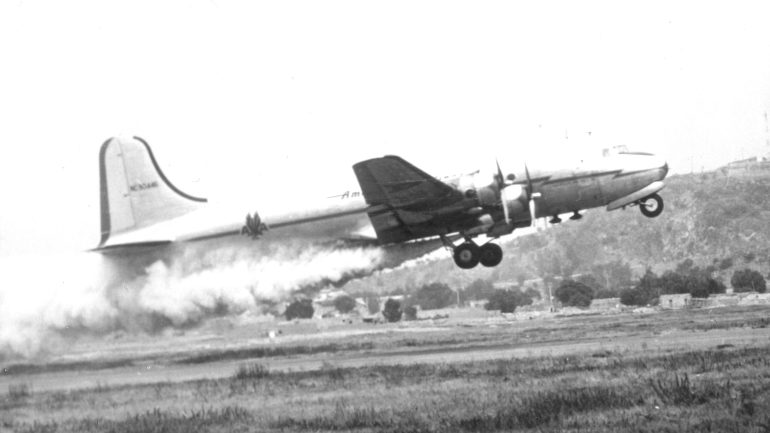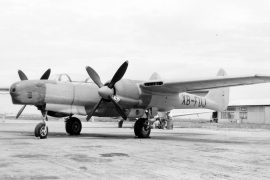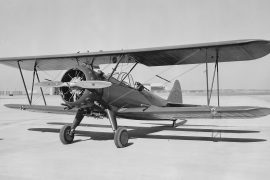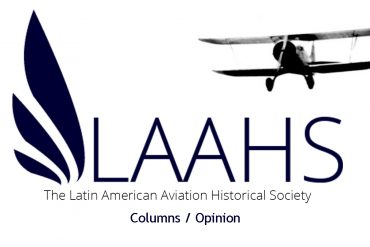Before the outbreak of World War Two, air travel was primarily limited to business professionals, affluent individuals, and celebrities. However, the war brought about a significant shift as transport planes were employed extensively in the distant battlefields of Europe and the Pacific. This unprecedented use of aircraft introduced millions of military and support personnel to the swiftness and convenience of modern air transportation. The development of larger and more secure planes during the war unmistakably showcased the practicality and logistical benefits of medium and long-distance air travel for both passengers and cargo.
After their military service, experienced airline executives, aircrew members, and ground crews played a crucial role in the military transport commands. Upon their discharge, they eagerly utilized their valuable expertise in the civilian aviation sector during the post-war period. This era witnessed a frenzied surge in airline growth and development, driven by the increasing demand for their services, the accessibility of relatively inexpensive surplus military transport aircraft, and the aviation manufacturing industry’s quest for conversion contracts to utilize their underutilized production facilities.
During the course of the war, the Navy and Army Air Forces exemplified the strategic significance of dedicated cargo planes for swift aerial transportation of essential goods and materials. This realization prompted civilian airlines, which had previously focused on carrying mail and a limited amount of “Express” freight on their passenger flights, to embrace this concept and swiftly establish a specialized air cargo industry. American Airlines took the lead by launching the first scheduled all-cargo domestic flight on October 15th, 1944. A DC-3 aircraft departed from New York to Los Angeles, carrying priority manufactured goods. Simultaneously, another DC-3 took off from the west coast, heading in the opposite direction, carrying spinach, fresh flowers, airplane parts, and clothing destined for markets on the east coast.
The DC-4 Freighter
Immediately after the war, as an interim measure, American Airlines acquired 50 surplus Douglas C-54, four-engine transports from the War Assets Corporation. The purchase price was $90,000 per plane. Republic Aviation Corporation at Farmingdale, New York was awarded the contract to convert them to civilian use, 47 of them as either 50 or 60 seat passenger planes, and the remaining three as dedicated DC-54-00 cargo ships. One of the latter was NC90446, a C-54B, serial number 42-72367, (Douglas msn 10472), that had originally been delivered to the USAAF on December 8, 1944. American Airlines acquired this particular C-54 on April 5, 1946. Almost new, it had only 2,000 hours on the airframe. The power plants that came with these large aircraft were the proven Pratt & Whitney model R-2000/2SD13G. Air cooled radials, they had 14 cylinders, arranged in two banks of seven, each engine capable of generating 1450 horse power for up to two minutes during take off. They were geared down to a 13 foot, one inch diameter, three blade Hamilton Standard Hydromatic propeller. The overall length of the DC-4 was 93 feet, 5 inches, and the wing span 117 feet, and 6 inches. For comparison, today’s popular Boeing 737-300 has an overall fuselage length of 105 feet, 7 inches, and a wingspan of 94 feet, 9 inches. The one major disadvantage of the DC-4 was that it was the last of the big transport aircraft to be un-pressurized, and therefore subject to the rigors of the weather in the lower atmosphere. When operating at the maximum gross weight, the never exceed speed in level flight was a respectable 218 knots, true indicated.
The Republic cargo conversion retained the large military door, whilst windows aft of station 301 were skinned over, and the interior finished with a cargo type lining and wall panels. Provision was made for four crew members. The plane weighed in empty at 37,867 pounds, and the maximum take off weight was set at 73,000 pounds. The converted NC90446 was accepted by American in late May 1946.
The Contract Air Cargo Division
In early June 1946, American Airlines established an independent operation known as the Contract Air Cargo Division -CACD- Heading up this operation was James A. Wooten, who had planned the venture, and convinced veteran president C. R. Smith, of the revenue generating and growth potential of an entirely separate air cargo division. The headquarters of the new company was set up at Rosecrans Field, an abandoned military base at St. Joseph, Missouri, selected primarily because of its strategic central location. Bill Hooten, who had earlier been the commanding officer at Rosecrans Field, returned to American from the Air Force as Director of Flight Operations, with R. N. “Russ” Arden as Chief Pilot. R. Dixon Speas became the new division’s Director of Engineering and Maintenance, and it was he who worked with Aerojet’s sales manager Eric Nelson, on the installation and certification of the JATO package on the DC-4. The aircraft assigned to the new venture included NC90446, were all cargo configured DC-4s. Based at major market airfields on the east and west coasts, the majority of the aircraft converged on St Joseph each night, creating the first “Hub”, long before it became today’s popular concept.
Unusual cargoes and overseas shipments became part of the total air freight package offered by CACD. One of the markets that they regularly served was Mexico City, and it was the problems associated with operation from this high, hot location, that prompted the development, certification, and very brief use of “The Rocket DC-4.”
The division’s objective was to operate the DC-4 from Mexico City to New York, non stop with a useful payload 20,000 pounds. Initial tests took place at La Guardia, and Mexico City in September 1946, concentrating on the drag lowering effect of reduced flap settings. American Airlines Chief Engineering Pilot, Glenn Brink, with Dan Beard and Douglas test pilot Johnny Martin flew the DC-4 to the limits of the flight envelope, yet failed to achieve the required improvement in the high altitude gross takeoff weight.
The remaining alternative solution was the use of Jet Assisted Take Off -JATO- a system developed during World War II to allow military aircraft to take off at high gross weights from carriers, and short landing strips.
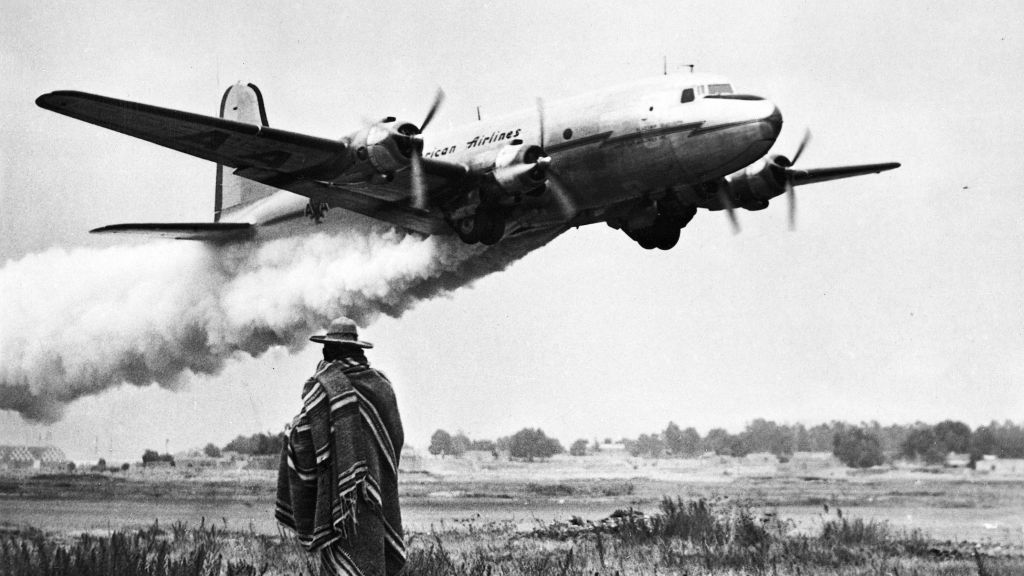
The Development of JATO
JATO is thought to have been conceived in May 1938, during a discussion between General “Hap” Arnold, and Dr. Theodore von Karman of the California Institute of Technology. The first successful demonstration was at March Field in California on August 16, 1941. An Ercoupe XPQ-13, fitted with three rocket motors under each wing, and flown by Captain Homer A. Bushey Jr., blasted off the runway, trailing a thick plume of lingering smoke. The real major development breakthrough came in the Spring of 1942, when John W. Parsons suggested a radical new solid propellant. This curious mixture of potassium perchlorate as oxidizer, and asphalt and lubricating oil as the fuel component, became the standard for the thousands of units used by the armed forces during World War II. Aerojet Engineering Corporation, of Azusa, California, was formed to manufacture and continue the development of the units. After the war, they vigorously sought civilian uses for their successful product. April 1946 the Civil Aeronautics Administration monitored a series of take offs at Ontario Army Airfield in Southern California. The aircraft was a C-47B, borrowed from the Air Service Technical Command, with two Aerojet 12AS-1000D-5 rocket motors mounted under the fuselage. Armed with the information and pictures gathered during these certification test flights, Aerojet approached the airlines, promoting the payload and safety advantages of their JATO system.
Aerojet’s “Geni in the steel bottle” consisted of the shaped charge, contained in a steel bottle with an electrically operated ignitor, and aft discharge nozzle. Once ignited, the rocket would burn for approximately 12 seconds, and each of the early designs developed a constant thrust of 1,000 pounds. Once fired the thrust could not be varied, or shut down until the end of the burn period. At 100 miles per hour, each unit developed a thrust approximately equivalent to 350 horse power. The bottles were approximately 36 inches long, 9 and 3/4 inches in diameter, and fully charged weighted 200 pounds.
In October 1946, American Airlines’ mechanics at Rosecrans Field installed four JATO motors, two under each wing, together with the associated fittings and wiring, on the DC-4 freighter NC90446. A temporary “NX” certification was sought for use during the certification flight tests, which began at St. Joseph on the 14th of October 1946. Pilot in command for the certification flights was New York based Captain Glenn Brink, then on his way to the Douglas plant at Long Beach, for the testing and delivery flight of American Airlines’ first DC-6. Assisted by Russ Arden, Glenn completed the arduous ground tests, that included an aborted take off immediately after the JATO units had been fired, producing hot brakes and blown tires. The flight tests proceeded satisfactorily, with the exception of the dive tests with the JATO bottles attached. A few knots short of Vd max., the rubber de-icing boots on one wing showed signs of coming off, and the test was terminated. This portion was later completed by Captain Thorn Wagner, and the DC-4 was licensed to use JATO. With the engineering, testing, and certification complete, the time had come for an actual commercial demonstration of the enhanced performance Douglas transport.
The New York Times of Sunday, December 15, 1946, announced that American Airlines would be the first to make commercial use of the war developed rocket boost on its commercial aircraft. The action moved to Mexico City, where the airport altitude was 7,300 feet.
JATO Speeds Bananas to New York
NC90446’s pilot on this occasion was George Wells. Born in Newfoundland, he learned to fly with Filmore Flying Service out of Oakland, California. He joined American in 1940, becoming a Captain in 1942. Returning from war time service with the ATC North Atlantic operation, he joined CACD, and flew many of their pioneering cargo flights, including the first load of live animals over the North Atlantic. Dixon Speas was also on hand with the team in Mexico City to handle any technical problems that might occur with the equipment. Following several trial take offs, the aircraft was loaded with boxes of bananas weighing 20,000 pounds and fueled up to the maximum gross weight for the 2,000 mile non stop flight to New York. The aircraft was accelerated to approximately 100 knots before the JATO units were fired, lifting the DC-4 smoothly off the long runway. The certification stipulated that the spent bottles could not be jettisoned, and on the long flight it became apparent that the additional drag had imposed an unexpected 8 knot speed penalty. Further as the plane proceeded over the gulf, three of the four fuel gauges became inoperative. Knowing that the fuel on board was marginal, a decision was made to first empty the tank with the good gauge, and then transfer a 100 gallons to that tank. It was then isolated and the engines run off the other tanks. If they ran dry, then with a known 100 gallons left on board, the DC-4 would be diverted to the nearest airport. Decision time came over the northeast coast, and the plane was put into Philadelphia for fuel. They hadn’t quite made it to their chosen destination, and though a weight/distance record had been established from Mexico City, the operation was not the phenomenal success that the airline had hoped for.
The experiment was never repeated, and though they looked briefly at their use on the Convair 240, American Airlines went out of the rocket assisted aircraft business. Early in 1947, a decision was made to close the maverick Contract Air Cargo Division, and consolidate it with American’s other operations which were at that time headquartered in New York City. The change was completed by June 1947, a year to the day since the division had been established in St Joseph. With the demise of CACD, James Wooten left American Airlines to head up Alaska Airlines, taking with him some of the key personnel from the short-lived cargo operation. He also made an arrangement with C. R. Smith to acquire two of American’s surplus DC-4s.
American Airlines operated their DC-4s for several more years. NC90446, its JATO units long since removed, was sold to United States Overseas Airlines in June 1954. They contracted with the Flying Tiger Line Inc., at Burbank to convert it to a 74 passenger configuration, and operated it until August 1957, when it was again sold, this time to S. E. Spicher of Miami, Florida for $650,000. Little is known of the aircraft history after 1957, and in October 1970, the FAA removed the Certificate of Aircraft Registration when Spicher failed to submit the necessary re-registration reports.
Other Civilian JATO Applications
JATO never achieved Aerojet’s forecast of widespread use in the civil aviation sector. In the US, a number of corporate and a few smaller airline DC-3s, including those of Aspen, and Purdue Aeron were fitted with the thrust augmenters. TACA experimented with Aerojet rockets on its DC-3s, during the same period as the American Airlines’ trials. Often operating from short isolated strips, this Central American airline made the first ever JATO take off of a scheduled commercial passenger flight. Panagra fitted JATO to both its DC-3s and DC-4s that operated out of La Paz in Bolivia. Aerojet lobbied hard for the use of its product both as a source of standby power, and for assisted take off on the Convair 240. However it was not until 1950 that the first application was found on Ethiopian Airlines’ new Convair 240s that would be operating out of hot and high airports in Africa.
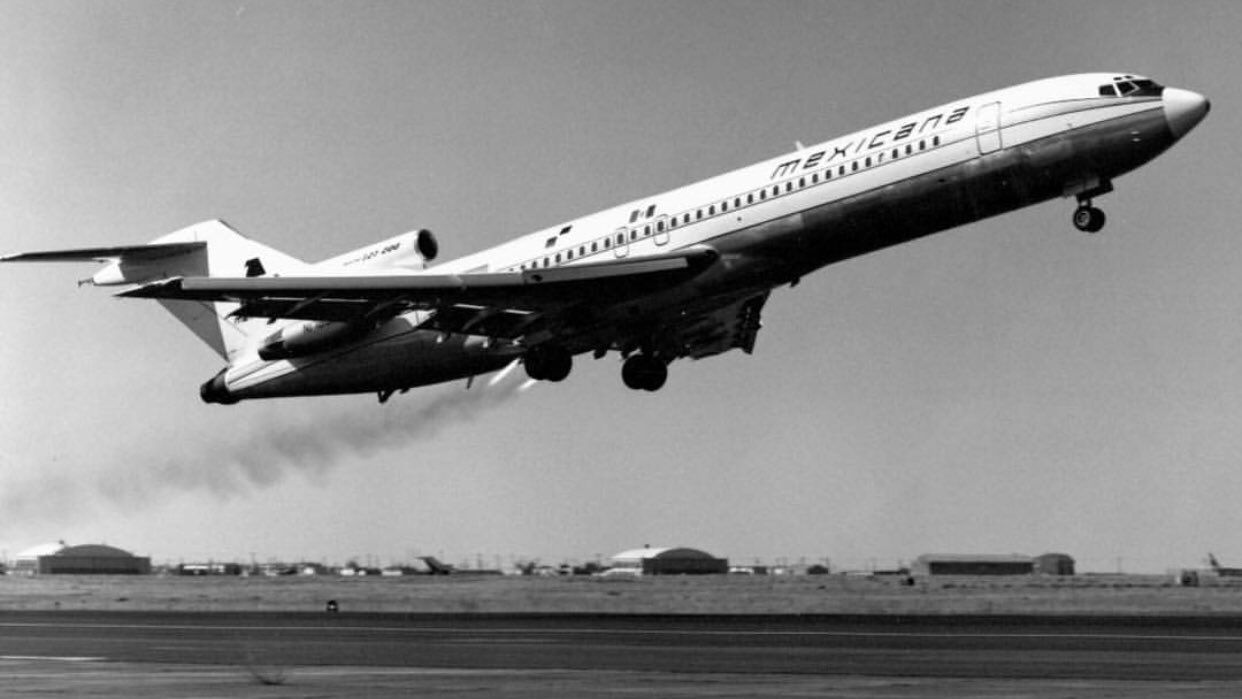
The ultimate use of Aerojet’s design appeared as late as 1970. Boeing delivered three 727-264s to Mexicana Airlines, all fitted with the latest smokeless jet assisted take off rocket installation. For the 155 passenger jet, the standby JATO equipment allowed the take off weight to be increased by up to 7,500 pounds. The first of these aircraft, N1780B, had three JATO units installed in each modified wing-fuselage fillet, immediately behind the trailing edge of each wing. Making an assisted take off on August 14, 1970, it became the largest civilian aircraft ever to have used the system. It proved to be JATO’s swan song. The rapid development of very high thrust, high by-pass jet engines made the added boost of the rocket motor totally superfluous for civilian airliners. Today’s traveler can only contemplate, and imagine the heart pounding sight of an airliner being thrust into the air by a smoke belching rocket.
The author wishes to acknowledge Otto Becker, Glenn Brink, George Wells, and Dixon Speas for the invaluable assistance that they gave during the preparation of this article.
This article was originally published in Airliners Magazine, issue #50, of March / April 1998.

